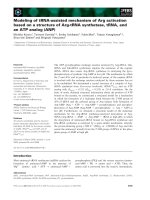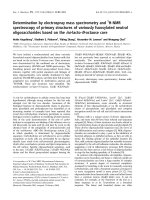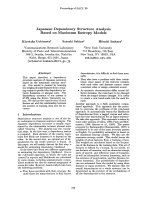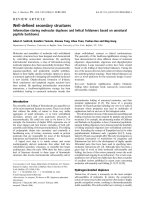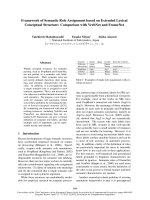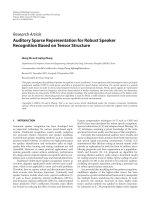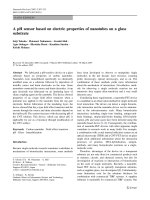Random lasers based on inverse photonic glass structure
Bạn đang xem bản rút gọn của tài liệu. Xem và tải ngay bản đầy đủ của tài liệu tại đây (779 KB, 6 trang )
Nghiên cứu khoa học công nghệ
Random lasers based on inverse photonic glass structure
Nguyen Minh Hoang1, Nguyen Van Toan2, Le Hoang Hai3, Ta Van Duong3*
1
School of Engineering Physics, Ha Noi University of Science and Technology;
Department of Physics, Le Quy Don Technical University;
3
Department of Optical Devices, Le Quy Don Technical University.
*
Corresponding author:
Received 15 Jun 2022; Revised 10 Aug 2022; Accepted 12 Dec 2022; Published 28 Dec 2022.
DOI: />2
ABSTRACT
Random laser has attracted much attention because of its unique physical properties and
potential applications in lighting, speckle-free imaging, biosensing, and photonic devices. In this
work, we confirm that scattering plays a vital role in random lasing. Then, we investigate lasing
properties of random film lasers with two scattering structures, including polystyrene
microparticles and air voids embedded in a polymer matrix with organic dye serving as a gain
medium. These two structures are called direct and inverse photonic glass, respectively. The
result indicates that random lasers based on inverse photonic glass have a lower threshold.
Following this achivement, we implemented inverse photonic glass into microspheres to obtain
random microlasers of different sizes. Our work shows that inverse photonic glass structure is an
excellent medium for random lasers with a wide range of sizes and dimensions. Especially, the
obtained random microlasers are promising for applications in microsensors and photonic
integrated circuits.
Keywords: Random laser; Inverse photonic glass; Microspheres.
1. INTRODUCTION
Random lasers have received significant interest due to their wide range of applications,
including cost-effective light sources, speckle-free laser imaging, and rich physical properties
[1]. The unique properties of a random laser are due to its structure. While a conventional laser
uses an optical cavity to trap and amplify light, a random laser does not have a cavity. It relies on
a disordered structure that amplifies light via multiple scattering [2, 3]. As a result, light
scattering plays an essential role in the realization of a random laser. Up to date, various
scattering structures have been used for random lasers, such as colloidal suspensions [4],
semiconductor powders [4], nanowires [5], and animal and human tissues [6, 7].
The easiest way to fabricate a random laser is to embed scattering particles like the
polystyrene (PS) microparticles into a polymer matrix with a gain medium. This structure can be
called a direct photonic glass and has been demonstrated to be suitable for random lasers.
Alternatively, a more advanced structure can be created from this direct photonic glass by
chemically etching the PS particles. The obtained structure is highly porous and contains air
voids in a polymer matrix, the so-called inverse photonic glass structure. Inverse photonic glass
has recently been demonstrated as an excellent structure for random microlasers [8-10]. Since the
refractive index contrast between the polymer and the air is generally higher than the PS particles
and the polymer, the inverse photonic glass should offer a larger scattering strength which is
more appropriate for random lasing. However, there is no report to confirm the advance of the
inverse photonic glass over the corresponding direct photonic glass structure.
In this work, we experimentally demonstrate that a random laser based on an inverse photonic
glass structure performs better, such as a lower lasing threshold than a random laser that relies on
the corresponding direct structure.
Tạp chí Nghiên cứu KH&CN quân sự, Số 84, 12 - 2022
127
Vật lý
2. EXPERIMENTAL
2.1. Fabrication of polymer films
Three types of polymer films have been fabricated: Film A is a plane film that does not
have scattering particles or air voids; Film B and C have a direct and inverse photonic glass
structure, respectively.
Firstly, 100 mg polyvinyl alcohol (PVA, from Sigma Aldrich) was dissolved in 2 mL water to
form a PVA solution of 5 wt%. Secondly, 0.2 mL aqueous Rhodamine B (RhB, dye >95%, from
Sigma Aldrich) solution (1 wt%) was added into the 2 mL PVA solution above and magnetic
stirring at 80 °C for 15 minutes. Finally, RhB-PVA film was fabricated by using a micropipette
to drop about 10 L of the solution onto a glass substrate and then dry at 80 oC for 30 minutes
(figure 1a, b).
To make a polymer film with a direct photonic structure, 0.5 mL aqueous suspension of
monodisperse PS microparticles (10 wt%) was added to 1 mL RhB-PVA solution. Then, we
dropped about 10 μL mixture onto a glass substrate and heated it at 80°C for 30 minutes (figure
1c, d). As a result, a dye-doped polymer film with embedded PS particles is obtained.
The fabrication process of an inverse photonic glass structure is the same as above, but
additional chemical etching was carried out by immersing the film in ethyl acetate solvent for 48
hours (figure 1e). The solvent dissolves the PS particles but does not affect the host material.
Thus a porous film is obtained [9].
(a)
Dry at 80 C
(b)
(d)
Film A
Film B
PS particles
RhB-PVA
solution
(c)
Film C
Etching
Air voids
PS particles
(e)
Droplets
Figure 1. Schematic diagram of the fabrication process of polymer films with various structures.
(a,b) Fabrication of polymer plane film (film A). (c,d) Fabrication of PS film
with direct photonic glass structure (film B). e) Fabrication of porous film
with inverse photonic glass structure (film C).
2.2. Fabrication of Microporous Spheres
Microporous spheres were fabricated using a self-assembled method and chemical etching
process, as reported in [9]. Firstly, a droplet of RhB-PVA-PS mixture (prepared in section 2.1)
was injected into a polydimethylsiloxane (PDMS) matrix (Sylgard 184 Silicon Elastomer from
Dow Corning). Secondly, the droplet was dispersed into many smaller droplets. These droplets
were then heated for 90 minutes to evaporate all water inside completely. After that, PDMS was
removed by ethyl acetate solvent. Finally, PS particles were also etched with ethyl acetate, and
porous polymer spheres with an inverse photonic glass structure were obtained.
2.3. Optical Measurement
We used a micro-photoluminescence (μ-PL) setup to study the dye-doped polymer films and
microporous spheres. The pumping wavelength is 532 nm with a repetition rate of 10 Hz and a
128
N. M. Hoang, …, T. V. Duong, “Random lasers based on inverse photonic glass structure.”
Nghiên cứu khoa học công nghệ
pulse duration of 8 ns (Canlas laser, CP 400-532). The focused laser beam spot is an ellipse with
semi-major and semi-minor axes of 320 µm and 106 µm, respectively. The spot area is 0.106
mm2. Emission from them was collected by a 10× objective and subsequently delivered to an
AvaSpec-2048L (Avantes) for spectral recording. The spectral resolution is ~ 0.2 nm. Optical
characterizations were carried out in the ambient air and at room temperature.
3. RESULTS AND DISCUSSION
3.1. Polymer film
Figure 2a shows a scanning electron microscopy (SEM) image (cross-section) of the RhBPVA film with a thickness of about 10
. Under optical pumping, this film has strong
photoluminescence and the emission spectra are plotted in figure 2b. It can be seen that the
emission intensity with increasing pump fluence. However, the full width at half maximum
(FWHM) of the spectra remains at about 50 nm, which is the characteristic of spontaneous
emission. As expected, stimulated emission is not observed, suggesting there is not any optical
feedback in the film. The result indicates that a scattering structure is needed to obtain stimulated
and subsequently random lasing emission.
(a)
(b)
Pump fluence
(J/mm2)
PL Intensity (a.u.)
800
10 μm
241
127
44
400
0
550
600
650
Wavelength (nm)
Figure 2. a) SEM image of a dye-doped polymer film;
b) Emission spectra of the film under different pump pulse fluences.
3.2. Polymer PS and porous films
Figures 3a and 3b present SEM images of a dye-doped polymer film with direct and inverse
photonic glass structure, respectively. The PS particles and air voids in the polymer matrix can
be observed clearly in the cross-section of the films. These structure scatters light strongly and
should play a significant role in the realization of random lasing.
Upon optical pumping, these films can work as random laser sources. Figure 3c plots
emission spectra of a dye-doped PS film as a function of pump fluences. It can be seen the
evolution from fluorescent when the fluence is lower than 154
to lasing emission when
it reaches 269
. The evidence of lasing emission is the reduction of the spectral linewidth
and the sharp increase of the PL emission. FWHM of the emission reduces from about 50 nm (at
pump fluence around 80
and lower) to around 7 nm at 269
. In addition, when
the pump fluence increases 1.7 times (from 154 to 269
), the emission intensity increases
more rapidly, 4 times (from 1200 to 4200 a. u.). This nonlinear dependence exhibits the
threshold behavior of the random laser. Similarly, lasing emission is also obtained from the film
with an inverse photonic glass structure. It is noticeable that the lasing spectrum is relatively
smooth, and no spikers were observed. It is because the transport mean free path of this structure
is around 3–7 µm which is much larger than the lasing wavelength (about 600 nm) [8]. In other
words, the laser works in a diffusive regime with incoherent feedback.
Tạp chí Nghiên cứu KH&CN quân sự, Số 84, 12 - 2022
129
Vật lý
Figure 3d plots the emission peak intensity versus pump fluences. It can be seen that the
emission peak intensity increases linearly with the pump fluence until a certain threshold value.
The lasing threshold of the film with a direct photonic glass structure is about 169
,
which is higher than the threshold of ~108
of the film with the inverse photonic glass
structure. It is understandable because the porous film has a higher refractive index contrast than
the PS film. Indeed, refractive index contrast of these films are Δni = npolymer - nair = 0.48 and Δnd
= nps - npolymer = 0.12 (nps = 1.6 is the refractive index of the PS [8], npolymer =1.48 is the refractive
index of polymer matrix [11]). As a result, the scattering mean free path of the porous film would
be smaller than that of PS film. Thus the porous film laser has a lower lasing threshold [12, 13].
The result indicates the advantage of inverse photonic glass structure compared to the direct
photonic glass structure.
6x104
5x104
(c)
5 μm
(b)
5 μm
4x104
PL Intensity (a.u.)
30μm
(d)
3x104
5x104
Pump fluence
(J/mm2)
269
211
154
80
44
0.4 mm
0.4 mm
Peak Intensity (a.u.)
(a)
2x104
1x104
30μm
0
550
Inverse structure
Direct structure
4x104
Threshold
162 J/mm2
3x104
2x104
Threshold
107 J/mm2
1x104
575
600
625
650
0
0
675
50
100
150
200
250
Pump pulse fluence (J/mm2)
Wavelength (nm)
Figure 3. a) and b) SEM and high-magnification SEM images of PS and porous polymer film,
respectively. c) Emission spectra of the PS film under various pump fluences.
d) Peak intensity of the PL emission of the PS film (red circle)
and porous film (circle with blue outline) versus pump pulse fluences.
3.3. Microporous Spheres
Figure 4 shows optical and SEM images of the fabricated microporous spheres. Their sizes
are distributed in the range from 10 to 100 μm (figure 4a). Their spherical shape is well
illustrated in figure 4b, while air voids and the polymer matrix are observed clearly in figure 4c.
(a)
(b)
(c)
100 μm
100 μm
5 μm
100
Figure 4.μm
a) Optical microscope image of fabricated microporous spheres with various
diameters ranging from 10 to 100 μm. b) SEM image of typical microporous spheres.
c) High-magnification SEM image of the porous structure.
Figures 5a and 5b demonstrate the evolution from fluorescent to lasing of two porous spheres.
Like the film random laser, when the pump fluence is smaller than the lasing threshold, the
sphere emits spontaneous emission characterized by low intensity and a broad spectrum. When
the pump fluence is greater than the lasing threshold, the emission intensity increases sharply,
130
N. M. Hoang, …, T. V. Duong, “Random lasers based on inverse photonic glass structure.”
Nghiên cứu khoa học công nghệ
and the spectral linewidth of the emission becomes much narrower. The lasing wavelengths at
the peak intensity of the 50 μm and 140 μm microspheres are 584.3 nm and 587.4 nm,
respectively. That means the lasing wavelength of the larger sphere is 3.1 nm red-shifted
compared with the smaller sphere. This phenomenon has been observed previously and
explained by the reabsorption of the dye molecules [9]. Light in the larger sphere travels a longer
path and the possibility of being obsorbed is higher. In addition, the shorter wavelength is
absorbed more than the longer wavelength. Therefore, laser emission is red-shifted with
increasing size.
The lasing threshold of the 50 μm microporous sphere is 37 μJ/mm2, while it is 30 μJ/mm2 for
the 140 μm microsphere (figure 5c). That means the smaller sphere has a higher threshold than
the larger sphere. It is because the light emission in the larger sphere can travel a longer path thus
light can be amplified better compared with the smaller sphere.
PL Intensity (a.u.)
5x104
4x10
(b)
Pump fluence
50 μm
(J/mm
50 μm
4
4x104
80
44
3x104
150 μm
31
18
8
2x104
Equation
Weight
Residual Sum
of Squares
50 m diameter sphere
140 m diameter sphere
Pearson's r
Adj. R-Square
B
4x104
3x104
Threshold
37 J/mm2
2x104 Threshold2
30 J/mm
1x104
1x104
1x104
6x104
5x104
Pump fluence
(J/mm2 )
150 μm
)
102
80
44
8
2
4
3x104
2x10
2
(c)
5x104
Peak Intensity (a.u.)
6x104
PL Intensity (a.u.)
(a)
0
0
550
575
600
Wavelength (nm)
625
0
550
575
600
625
Wavelength (nm)
650
0
30
60
90
120
Pump pulse fluence (J/mm2)
Figure 5. a) and b) Emission spectra of a 50 μm and 140 μm diameter sphere
under various pump pulse fluences, respectively. c) Corresponding PL peak intensity
of these two spheres versus pump fluence.
4. CONCLUSIONS
We have demonstrated that scattering plays a significant role in random lasing. Then, we
fabricated polymer film with two scattering structures, the direct photonic glass structure (PS
microparticles embedded in a polymer matrix) and the inverse photonic glass structure (air voids
in a polymer matrix). The result indicates that a random laser based on the inverse photonic glass
structure performs better, such as a lower lasing threshold. Owning the advantages of the inverse
photonic glass structure, we implemented it into porous microspheres and the obtained
microspheres can work as random microlasers. Our work provides a unique and simple technique
for fabricating film-shaped and spherical random lasers with good characteristics.
Acknowledgment: This research is funded by Le Quy Don Technical University, Viet Nam under
grant number 20.1.029. The authors thank Mr Nguyen Trong Tam and Associate Professor Mai Hong
Hanh for support in optical characterizations.
REFERENCES
[1]. Luan F, Gu B, Gomes ASL, Yong K-T, Wen S, Prasad PN. "Lasing in nanocomposite random
media". Nano Today, Vol. 10, pp. 168-192, (2015).
[2]. Cao H. "Lasing in random media". Waves in Random Media, Vol. 13, pp. R1-R39, (2003).
[3]. [3]. Wiersma DS, Lagendijk A. "Light diffusion with gain and random lasers". Physical Review E,
Vol. 54, pp. 4256-4265, (1996).
[4]. Cao H, Zhao YG, Ho ST, Seelig EW, Wang QH, Chang RPH. "Random Laser Action in
Semiconductor Powder". Physical Review Letters, Vol. 82 , pp. 2278-2281, (1999).
[5]. Chen R, Ye Q-L, He T, Ta VD, Ying Y, Tay YY, et al. "Exciton Localization and Optical Properties
Tạp chí Nghiên cứu KH&CN quân sự, Số 84, 12 - 2022
131
Vật lý
Improvement in Nanocrystal-Embedded ZnO Core–Shell Nanowires". Nano Letters, Vol. 13, pp. 734739, (2013).
[6]. Polson RC, Vardeny ZV. "Random lasing in human tissues". Applied Physics Letters, Vol. 85, pp.
1289-1291, (2004).
[7]. Siddique M, Yang L, Wang QZ, Alfano RR. "Mirrorless laser action from optically pumped dyetreated animal tissues". Optics Communications, Vol. 117, pp. 475-479, (1995).
[8]. Caixeiro S, Gaio M, Marelli B, Omenetto FG, Sapienza R. "Silk-Based Biocompatible Random
Lasing". Advanced Optical Materials, Vol. 4, pp. 998-1003, (2016).
[9]. Ta VD, Caixeiro S, Saxena D, Sapienza R. "Biocompatible Polymer and Protein Microspheres with
Inverse Photonic Glass Structure for Random Micro-Biolasers". Advanced Photonics Research, Vol.
2, pp. 2100036, (2021).
[10]. Ta VD, Saxena D, Caixeiro S, Sapienza R. "Flexible and tensile microporous polymer fibers for
wavelength-tunable random lasing". Nanoscale, Vol. 12, pp. 12357-12363, (2020).
[11]. Ta VD, Nguyen Thiet V, Pham Quan V, Nguyen Toan V. "Biocompatible microlasers based on
polyvinyl alcohol microspheres". Optics Communications, Vol. 459, pp. 124925, (2020).
[12]. Sha WL, Liu CH, Alfano RR. "Spectral and temporal measurements of laser action of Rhodamine
640 dye in strongly scattering media". Optics Letters, Vol. 19, pp. 1922-1924, (1994).
[13]. Wiersma D. "The smallest random laser". Nature, Vol. 406, pp. 133-135, (2000).
TÓM TẮT
Laser ngẫu nhiên dựa trên cấu trúc thủy tinh quang tử ngược
Laser ngẫu nhiên đang thu hút được sự quan tâm nghiên cứu vì chúng có các tính chất
vật lý độc đáo và tiềm năng ứng dụng trong các lĩnh vực như chiếu sáng, tạo ảnh, cảm
biến sinh học và thiết bị quang tử. Trong bài báo này, trước tiên chúng tôi chứng minh
rằng tán xạ đóng vai trị quyết định trong việc tạo ra laser ngẫu nhiên. Sau đó, chúng tơi
nghiên cứu các đặc tính phát quang của laser ngẫu nhiên từ màng polyme pha hoạt chất
màu hữu cơ (đóng vai trị như mơi trường khuếch đại) với hai đặc tính khác nhau: các vi
hạt nhựa sắp xếp chặt chẽ và cấu trúc xốp với nhiều lỗ rỗng. Hai cấu trúc này lần lượt
được gọi là thủy tinh quang tử thuận và ngược. Kết quả chỉ ra rằng laser ngẫu nhiên dựa
trên cấu trúc thủy tinh quang tử ngược có ngưỡng phát thấp hơn. Cuối cùng, chúng tôi đã
chế tạo thành cơng các hạt vi cầu có cấu trúc thủy tinh quang tử ngược và nghiên cứu
được đặc trưng phát laser ngẫu nhiên của chúng. Dữ liệu thu được cho thấy thủy tinh
quang tử ngược là cấu trúc tốt để tạo ra các nguồn vi laser ngẫu nhiên với kích thước và
hình dạng khác nhau. Các vi laser ngẫu nhiên đã chế tạo được có triển vọng ứng dụng
trong vi cảm biến và vi mạch tích hợp quang tử.
Từ khóa: Laser ngẫu nhiên; Thủy tinh quang tử ngược; Vi cầu.
132
N. M. Hoang, …, T. V. Duong, “Random lasers based on inverse photonic glass structure.”
